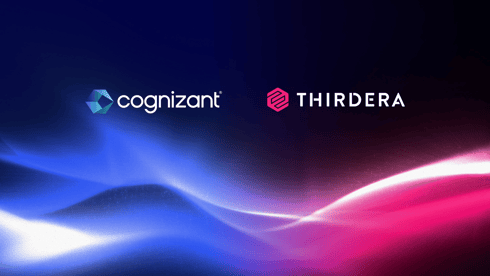Financial services, meet the future with...
Banks, credit unions, investment firms, and brokerages have relied on AI-driven tools for a longer period of time that almost any other business sector. It makes sense—large...
Read MoreThirdera generates transformation, digitization, and automation for our customers at the speed of NOW.
We help organizations adopt better patterns of work and get more from ServiceNow. Our team unlocks enterprise potential to elevate experiences across the world of work.
We help organizations adopt better patterns of work and get more from ServiceNow. Our team unlocks enterprise potential to elevate experiences across the world of work.

Exciting news! Thirdera and Cognizant Awarded Three ServiceNow Partner Specializations
Read more.jpg?width=500&height=276&name=filter%20group%20of%20people%20at%20desk%20laptop%20laughing%202021-10%20(1).jpg)


Insurance Provider Projects $75MM Gain in Business Value from Asset Management Transformation
Read more-1.jpeg?width=500&height=276&name=Indiana%20Department%20of%20Transportation%20Case%20Study%202023-03%20(3)-1.jpeg)
Government Agency INDOT Modernizes Its Constituent Service Model with CitizenKey
Read more.jpg?width=500&height=276&name=Multichannel%20pipette%20tips%20reaction%20mixture%20plastic%20wells%202022-05%20(1).jpg)

Balancing mission-driven goals with operational efficiency requires innovative solutions that can streamline processes, and enhance program delivery without straining budgets.

UN Agencies Rely on Thirdera and ServiceNow to Support the Ukrainian Aid Response
Read moreDigitize and automate workflows to enhance the customer experience, online and in-store.

.jpg?width=500&height=276&name=Servers%20data%20center%20room%20with%20bright%20speed%20light%202022-05%20(3).jpg)
Global SAP on Cloud Leader, Lemongrass, Embarks on Multi-Continent ITSM Overhaul
Read more

Stay up to date with the insights from ServiceNow experts and explore our blogs, news, case studies culture posts, partner updates and more.
Stay up to date with the insights from ServiceNow experts and explore our blogs, news, case studies culture posts, partner updates and more.


In recent years, many organizations have outgrown their existing work management solutions for Human Resources (HR) operations. Many of these companies had been using ServiceNow's Incident Management or Service Catalog solutions to support HR functions but soon encountered challenges as their needs evolved. In this blog post, we'll explore the benefits of migrating to ServiceNow's dedicated HR Service Delivery (HRSD) solution and how it can address common pain points.
Companies using IT Service Management (ITSM) tools like Incident Management or Service Catalog to support HR operations often face limitations in expanding their capabilities to meet growing employee demands across multiple locations or regions. One global medical device company, for instance, wanted to provide the same level of HR service to all employees worldwide - across 75 countries - but their existing ITSM solution couldn't scale efficiently to support that global expansion. By migrating to HRSD, they were able to provide self-service capabilities to all employees in just 7 months. The implementation involved building over 200 services in 7 languages, while also enabling the company's HR IT team to take control of the governance process within the HRSD application.
When organizations use custom applications or repurpose ITSM tools for HR operations, there is an inherent risk of exposing sensitive employee data to non-HR teams. This is because employees expect a high degree of confidentiality when contacting HR, which is not always possible when managing HR inquiries through general-purpose tools like Incident Management. Additionally, managing custom security rules for these improvised solutions can be cumbersome, hindering rapid expansion and requiring extensive regression testing for any security changes.
The need for robust data security was evident in one organization that had to manage leave and accommodation requests via emails and spreadsheets, despite other HR teams using Incident Management. This workaround was necessary to maintain isolated access due to the sensitive nature of these requests. By implementing HRSD, the company could leverage out-of-the-box security policies to limit access to these cases to a small, authorized group.
Another company faced a similar challenge, needing to restrict the visibility of HR cases based on the employee's department, routing HR-specific cases to a specialized group. This level of granular access control would have required extensive customizations in their existing Service Catalog implementation but was readily achievable with HRSD’s built-in security features.
When moving from a custom or ITSM-based solution to HR Service Delivery, a common question is: "What do we do with the existing tickets?" The recommended approach is to leave legacy tickets in their original location and have a transition period where old tickets are closed out, and new cases are created in HRSD. If using Employee Center, employees will experience minimal disruption when accessing their requests via the portal. To minimize the impact on HR teams, configure the HR Agent Workspace to access legacy tickets, eliminating the need to navigate multiple locations within ServiceNow.
Since 2013, ServiceNow has continuously invested in enhancing its HR Service Delivery product. Customers using Incident or Service Catalog for HR operations haven't been able to take advantage of these improvements. From major features like the HR profile record for storing sensitive employee data and automating processes like providing employee verification letters with salary information, to smaller enhancements like the recent Personal Notes feature in the Washington, D.C. release.
Continually using custom or legacy solutions means missing out on these new features, as they're not always available outside the HR product. To leverage these improvements, customers would have to build and maintain them independently, increasing technical debt. Once the debt becomes too high to unwind, many customers find themselves in a position where they must undertake a "back to box" migration to HRSD.
If you're feeling restricted by your current work management solution for HR, whether due to limitations or an inability to take advantage of new features, it's time to evaluate implementing ServiceNow HRSD. By doing so, you can address expansion challenges, enhance security, streamline data migration, and benefit from continuous product improvements – ultimately providing a better experience for your employees and HR teams.
Banks, credit unions, investment firms, and brokerages have relied on AI-driven tools for a longer period of time that almost any other business sector. It makes sense—large...
Read MoreGrouping all patient care-related businesses under "the healthcare industry" is as oversimplified as describing our work as "something with AI." Thirdera, a Cognizant company,...
Read MoreThe ServiceNow Yokohama release became generally available on March 12, 2025, revolutionizing the NOW Platform with transformative enterprise AI capabilities. This release unifies...
Read MoreThe clock is ticking for organizations still running Windows 10. Microsoft has announced that Windows 10 will reach its end of support on October 14, 2025, meaning no more...
Read More